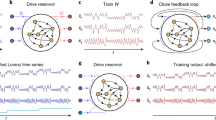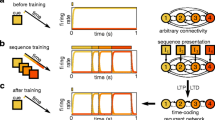Abstract
In this work, we consider recurrent neural networks of firing rate neurons supervisely trained to generate multidimensional sequences of given configurations. We study dynamical objects in the network multidimensional phase space underlying successfully trained outputs and analyze spatiotemporal neural activity and its features in three cases. First, we consider autonomous generation of complex sequences by output units driven by a recurrent network. Second, we study how input pulses can trigger different output units. Third, we explore the case where input pulses allow us to switch between different sequential activities of output units.




Similar content being viewed by others
References
Marblestone, A.H., Wayne, G., Kording, K.P.: Toward an integration of deep learning and neuroscience. Front. Comput. Neurosci. 10, 94 (2016)
Barak, O.: Recurrent neural networks as versatile tools of neuroscience research. Curr. Opin. Neurobiol. 46, 1–6 (2017)
Sussillo, D.: Neural circuits as computational dynamical systems. Curr. Opin. Neurobiol. 25, 156–163 (2014)
Buonomano, D.V., Maass, W.: State-dependent computations: spatiotemporal processing in cortical networks. Nat. Rev. Neurosci. 10(2), 113 (2009)
Graves, A., Mohamed, A.r., Hinton, G.: Speech recognition with deep recurrent neural networks. In: 2013 IEEE International Conference on Acoustics, Speech and Signal Processing, pp. 6645–6649. IEEE (2013)
Venugopalan, S., Xu, H., Donahue, J., Rohrbach, M., Mooney, R., Saenko, K.: Translating videos to natural language using deep recurrent neural networks (2014). arXiv preprint arXiv:1412.4729
Churchland, M.M., Byron, M.Y., Cunningham, J.P., Sugrue, L.P., Cohen, M.R., Corrado, G.S., Newsome, W.T., Clark, A.M., Hosseini, P., Scott, B.B., et al.: Stimulus onset quenches neural variability: a widespread cortical phenomenon. Nat. Neurosci. 13(3), 369 (2010)
Mante, V., Sussillo, D., Shenoy, K.V., Newsome, W.T.: Context-dependent computation by recurrent dynamics in prefrontal cortex. Nature 503(7474), 78 (2013)
Laje, R., Buonomano, D.V.: Robust timing and motor patterns by taming chaos in recurrent neural networks. Nat. Neurosci. 16(7), 925 (2013)
Douglas, R.J., Martin, K.: A functional microcircuit for cat visual cortex. J. Physiol. 440(1), 735–769 (1991)
Gerstner, W., van Hemmen, J.L.: Associative memory in a network of spiking neurons. Netw. Comput. Neural Syst. 3(2), 139–164 (1992)
Sommer, F.T., Wennekers, T.: Associative memory in networks of spiking neurons. Neural Netw. 14(6–7), 825–834 (2001)
Zamani, M., Sadeghian, A., Chartier, S.: A bidirectional associative memory based on cortical spiking neurons using temporal coding. In: The 2010 International Joint Conference on Neural Networks (IJCNN), pp. 1–8. IEEE (2010)
Amit, D.J., Mongillo, G.: Spike-driven synaptic dynamics generating working memory states. Neural Comput. 15(3), 565–596 (2003)
Miller, P., Brody, C.D., Romo, R., Wang, X.J.: A recurrent network model of somatosensory parametric working memory in the prefrontal cortex. Cerebral Cortex 13(11), 1208–1218 (2003)
Mongillo, G., Barak, O., Tsodyks, M.: Synaptic theory of working memory. Science 319(5869), 1543–1546 (2008)
Szatmáry, B., Izhikevich, E.M.: Spike-timing theory of working memory. PLoS Comput. Biol. 6(8), e1000879 (2010)
Buzsaki, G.: Rhythms of the Brain. Oxford University Press, Oxford (2006)
Melamed, O., Barak, O., Silberberg, G., Markram, H., Tsodyks, M.: Slow oscillations in neural networks with facilitating synapses. J. Comput. Neurosci. 25(2), 308 (2008)
Izhikevich, E.M., Edelman, G.M.: Large-scale model of mammalian thalamocortical systems. Proc. Natl. Acad. Sci. 105(9), 3593–3598 (2008)
Ma, J., Wu, J.: Multistability in spiking neuron models of delayed recurrent inhibitory loops. Neural Comput. 19(8), 2124–2148 (2007)
Graves, A., Schmidhuber, J.: Offline handwriting recognition with multidimensional recurrent neural networks. In: Koller, D., Schuurmans, D., Bengio, Y., Bottou, L. (eds.) Advances in Neural Information Processing Systems 21, Curran Associates, Inc., pp. 545–552 (2009). http://papers.nips.cc/paper/3449-offline-handwriting-recognition-with-multidimensional-recurrent-neural-networks.pdf
Zaremba, W., Sutskever, I., Vinyals, O.: Recurrent neural network regularization (2014). arXiv preprint arXiv:1409.2329
Hewamalage, H., Bergmeir, C., Bandara, K.: Recurrent neural networks for time series forecasting: Current status and future directions (2019). arXiv preprint arXiv:1909.00590
Chung, J., Gulcehre, C., Cho, K., Bengio, Y.: Empirical evaluation of gated recurrent neural networks on sequence modeling (2014). arXiv preprint arXiv:1412.3555
Medsker, L., Jain, L.C.: Recurrent Neural Networks: Design and Applications. CRC Press, Bocaraton (1999)
Hochreiter, S., Schmidhuber, J.: Long short-term memory. Neural Comput. 9(8), 1735–1780 (1997)
Schuster, M., Paliwal, K.K.: Bidirectional recurrent neural networks. IEEE Trans. Signal Process. 45(11), 2673–2681 (1997)
Cheng, C.Y., Lin, K.H., Shih, C.W.: Multistability in recurrent neural networks. SIAM J. Appl. Math. 66(4), 1301–1320 (2006)
Kaslik, E., Sivasundaram, S.: Impulsive hybrid discrete-time hopfield neural networks with delays and multistability analysis. Neural Netw. 24(4), 370–377 (2011)
Yi, Z., Tan, K.K., Lee, T.H.: Multistability analysis for recurrent neural networks with unsaturating piecewise linear transfer functions. Neural Comput. 15(3), 639–662 (2003)
Hochreiter, S., Bengio, Y., Frasconi, P., Schmidhuber, J., et al.: Gradient flow in recurrent nets: the difficulty of learning long-term dependencies. In: Kolen, J. F., Kremer S. C. (eds.) A Field Guide to Dynamical Recurrent Networks. IEEE Press New York City, pp. 237–244 (2000)
Hertz, J.A.: Introduction to the Theory of Neural Computation. CRC Press, Boca Raton (2018)
Maass, W., Natschläger, T., Markram, H.: Real-time computing without stable states: a new framework for neural computation based on perturbations. Neural Comput. 14(11), 2531–2560 (2002)
Jaeger, H., Haas, H.: Harnessing nonlinearity: predicting chaotic systems and saving energy in wireless communication. Science 304(5667), 78–80 (2004)
Sussillo, D., Abbott, L.F.: Generating coherent patterns of activity from chaotic neural networks. Neuron 63(4), 544–557 (2009)
Martens, J., Sutskever, I.: Learning recurrent neural networks with hessian-free optimization. In: Proceedings of the 28th International Conference on Machine Learning (ICML-11), pp. 1033–1040. Citeseer (2011)
Bengio, Y., Boulanger-Lewandowski, N., Pascanu, R.: Advances in optimizing recurrent networks. In: 2013 IEEE International Conference on Acoustics, Speech and Signal Processing, pp. 8624–8628. IEEE (2013)
Hoerzer, G.M., Legenstein, R., Maass, W.: Emergence of complex computational structures from chaotic neural networks through reward-modulated hebbian learning. Cerebral Cortex 24(3), 677–690 (2014)
Song, H.F., Yang, G.R., Wang, X.J.: Training excitatory-inhibitory recurrent neural networks for cognitive tasks: a simple and flexible framework. PLoS Comput. Biol. 12(2), e1004792 (2016)
Lukoševičius, M., Jaeger, H.: Reservoir computing approaches to recurrent neural network training. Comput. Sci. Rev. 3(3), 127–149 (2009)
Schrauwen, B., Verstraeten, D., Van Campenhout, J.: An overview of reservoir computing: theory, applications and implementations. In: Proceedings of the 15th European Symposium on Artificial Neural Networks, pp. 471–482 (2007)
Atiya, A.F., Parlos, A.G.: New results on recurrent network training: unifying the algorithms and accelerating convergence. IEEE Trans. Neural Netw. 11(3), 697–709 (2000)
Lukoševičius, M., Jaeger, H., Schrauwen, B.: Reservoir computing trends. KI-Künstliche Intelligenz 26(4), 365–371 (2012)
Jaeger, H.: Short term memory in echo state networks, vol. 5. GMD-Forschungszentrum Informationstechnik (2001)
Ponulak, F., Kasinski, A.: Introduction to spiking neural networks: Information processing, learning and applications. Acta Neurobiologiae Experimentalis 71(4), 409–433 (2011)
Sussillo, D., Barak, O.: Opening the black box: low-dimensional dynamics in high-dimensional recurrent neural networks. Neural Comput. 25(3), 626–649 (2013)
DePasquale, B., Cueva, C.J., Rajan, K., Abbott, L., et al.: Full-force: a target-based method for training recurrent networks. PloS One 13(2), e0191527 (2018)
Maslennikov, O.V., Nekorkin, V.I.: Collective dynamics of rate neurons for supervised learning in a reservoir computing system. Chaos Interdiscip. J. Nonlinear Sci. 29(10), 103126 (2019)
Abbott, L.F., DePasquale, B., Memmesheimer, R.M.: Building functional networks of spiking model neurons. Nat. Neurosci. 19(3), 350 (2016)
Nicola, W., Clopath, C.: Supervised learning in spiking neural networks with force training. Nat. Commun. 8(1), 2208 (2017)
Kim, C.M., Chow, C.C.: Learning recurrent dynamics in spiking networks. eLife 7, e37124 (2018)
Pugavko, M.M., Maslennikov, O.V., Nekorkin, V.I.: Dynamics of a network of map-based model neurons for supervised learning of a reservoir computing system. Izvestiya VUZ Appl. Nonlinear Dyn. 28(1), 77–89 (2019). https://doi.org/10.18500/0869-6632-2020-28-1-77-89
Pugavko, M. M., Maslennikov, O. V., Nekorkin, V. I.: Dynamics of spiking map-based neural networks in problems of supervised learning. Commun. Nonlinear Sci. Numer. Simul. 105399 (2020). https://doi.org/10.1016/j.cnsns.2020.105399
Rajan, K., Abbott, L.: Eigenvalue spectra of random matrices for neural networks. Phys. Rev. Lett. 97(18), 188104 (2006)
Rivkind, A., Barak, O.: Local dynamics in trained recurrent neural networks. Phys. Rev. Lett. 118(25), 258101 (2017)
Schuessler, F., Dubreuil, A., Mastrogiuseppe, F., Ostojic, S., Barak, O.: Dynamics of random recurrent networks with correlated low-rank structure. Phys. Rev. Res. 2(1), 013111 (2020)
Mastrogiuseppe, F., Ostojic, S.: Linking connectivity, dynamics, and computations in low-rank recurrent neural networks. Neuron 99(3), 609–623 (2018)
Rajan, K., Harvey, C.D., Tank, D.W.: Recurrent network models of sequence generation and memory. Neuron 90(1), 128–142 (2016)
Rajan, K., Abbott, L., Sompolinsky, H.: Stimulus-dependent suppression of chaos in recurrent neural networks. Phys. Rev. E 82(1), 011903 (2010)
Sompolinsky, H., Crisanti, A., Sommers, H.J.: Chaos in random neural networks. Phys. Rev. Lett. 61(3), 259 (1988)
Luczak, A., McNaughton, B.L., Harris, K.D.: Packet-based communication in the cortex. Nat. Rev. Neurosci. 16(12), 745–755 (2015)
Haykin, S.S.: Adaptive Filter Theory. Pearson Education India, Bengaluru (2005)
Benettin, G., Galgani, L., Giorgilli, A., Strelcyn, J.M.: Lyapunov characteristic exponents for smooth dynamical systems and for hamiltonian systems; a method for computing all of them. part 1: Theory. Meccanica 15(1), 9–20 (1980)
Abrams, D.M., Strogatz, S.H.: Chimera states for coupled oscillators. Phys. Rev. Lett. 93(17), 174102 (2004)
Panaggio, M.J., Abrams, D.M.: Chimera states: coexistence of coherence and incoherence in networks of coupled oscillators. Nonlinearity 28(3), R67 (2015)
Kasatkin, D.V., Klinshov, V.V., Nekorkin, V.I.: Itinerant chimeras in an adaptive network of pulse-coupled oscillators. Phys. Rev. E 99(2), 022203 (2019)
Acknowledgements
Studying autonomous dynamics in this work was carried out as part of the state assignment of the IAP RAS, project No. 0035-2019-0011. Studying stimulus-driven dynamics was supported by the Russian Science Foundation, Project No. 19-72-00112.
Author information
Authors and Affiliations
Corresponding author
Ethics declarations
Conflict of interest
The authors declare that they have no conflict of interest.
Additional information
Publisher's Note
Springer Nature remains neutral with regard to jurisdictional claims in published maps and institutional affiliations.
Studying autonomous dynamics in this work was carried out as part of the state assignment of the IAP RAS, project No. 0035-2019-0011. Studying stimulus-driven dynamics was supported by the Russian Science Foundation, Project No. 19-72-00112.
Rights and permissions
About this article
Cite this article
Maslennikov, O.V., Nekorkin, V.I. Stimulus-induced sequential activity in supervisely trained recurrent networks of firing rate neurons. Nonlinear Dyn 101, 1093–1103 (2020). https://doi.org/10.1007/s11071-020-05787-0
Received:
Accepted:
Published:
Issue Date:
DOI: https://doi.org/10.1007/s11071-020-05787-0




